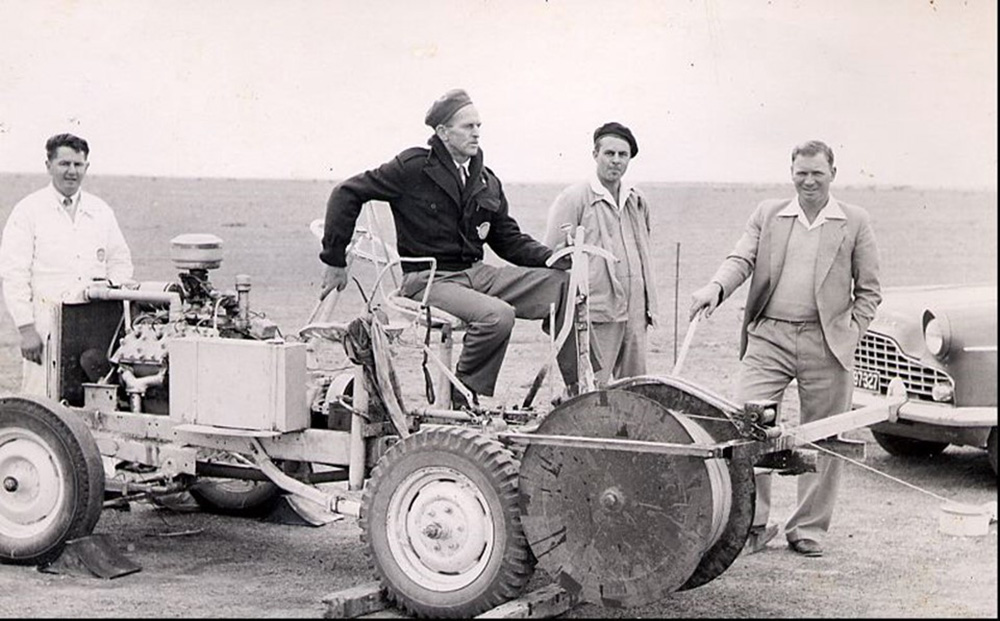
The original winch - driver, spreader operator and two mechanics, just in case.
By Terry Neumann
In the early the history of Balaklava GC, winch manufacture and design was governed by the availability of materials and the skill and imagination of the people who built them. There was no 'standard' winch design, and in our club as elsewhere, what finally appeared was governed (limited) by those fundamental parameters. The first two pictures come from the club photographic history; the third is from my own collection. The notes here are from what I recall, partly by club folk lore and history - often absorbed during valuable time spent around the bar in the early days - and partly from my own experiences since I joined in 1966. Most of it I believe to be essentially accurate - remembering the origin as mentioned - but like many gliding stories, the absolute truth cannot be always vouched for. Accordingly, you need to keep that in mind as you read on.
Here are two of the machines that saw service in the Clare Soaring Club - our club - and the first two pictures are of the very first one reportedly built by Herb Heinrich and others. It would spend the operational day at the other end of the strip to the launch point, and the cable (multi stranded) was towed back to the launch point by another vehicle after each launch.

During a launch. The spreader operator in this instance is Herb Habisch.
Of course, this meant the overall operation was much slower than what we now enjoy, and there was also much more abrasion on the cable as a further consequence. The engine is a side valve Ford V8 driving though a manual clutch and gearbox to a single drum, with a manual spreader operated by a person just slightly less brave than the driver. Pictured here are Headley Neumann, Clive Wake, Dean Underwood and (I think) Hedley Wandel. Astonishingly perhaps, it appears that no injuries were ever sustained in its lifetime - at least that history records. It would probably have some difficulty in passing today's safety standards.
The third picture is one of the ‘Cactus’ winch built by Ken Cathery and others. The basic vehicle is an ex military Ford truck - again with a V8 side valve motor. But besides being the power unit for the vehicle itself to make the trip up and down the strip in the way we do now, it also drives the winch drum(s) to perform the launching function. A transfer box disengaged the drive train to the wheels once it arrived at the far end of the strip in use, and the drum to be used was selected by the insertion of a dirty (oily) great pin that engaged the drum with the drive axle, which rotated within the hub of both drums - a kind of free-wheel effect at other times.
It's also self spreading due to the large diameter narrow drums, which means that it can be operated by one person within the relative safety of the cabin. This was the winch in use when I joined the club. Single strand high tensile fencing wire was now the launching cable - probably an improvement in some respects over the stranded cable, certainly in cost and ease of handling. The stranded cable became very prickly as it wore.
There possibly were more cable breaks, but repair was simple, and potential cable break practise was never far from the instructor's and student's minds. There was none of this automatic transmission stuff we enjoy now - a manual clutch and gearbox was the go. For those of us who hadn't learned the subtle art of double de-clutching for gear shifts when driving the winch down the strip and back (and elsewhere), it eventually became a skill everyone acquired.

The Cactus winch - Bill Winton is unloading the drogues and traces at the RW16 launch point. Sophistication and safety innovations are to be seen everywhere in this radical new design.
Third gear was selected for most of the launches in normal operations, and manual clutch engagement was another skill to be perfected. Even so, it was a good launch if you got to 1,000ft in the Kookaburra on 16/34, and I can assure you that in the winter of 1966 when I did my training, spin demonstration and recovery from that altitude or less was an experience something between an extreme adventure and a horror movie.
I only ever had one thermal flight in my training in that period, and the log book records most of my flights as being three or four minutes in duration.































